Top News
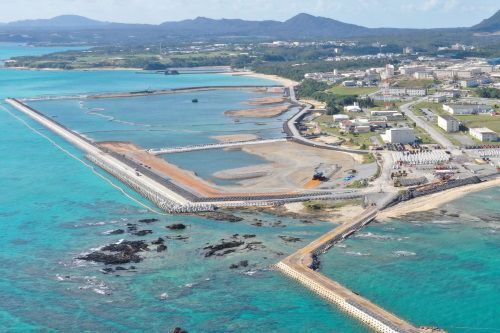
January 5, 2020 Ryukyu Shimpo
Tokyo – The Ministry of Defense (MoD) has decided to postpone two projects appropriated for 2019 related to the new base construction in Henoko, Nago City, such as the redirection of a waterway that runs through Camp Schwab.
This was done in order to prioritize the necessary improvement of the soft ground that will serve as the foundation of the new base.
The budget for the postponed projects (approximately 16 billion yen) will instead be put towards land acquisition on Mageshima (Nishinoomote City) in Kagoshima prefecture, one of the candidate sites for relocating the U.S. military’s field carrier landing practice (FCLP), which involves Navy aircraft landing on aircraft carriers.
Okinawa has indicated a policy of not consenting to the change in plans regarding the fortification of the soft ground in Henoko bay, and is unable to forecast when the two postponed projects will begin.
The two postponed projects are the redirection of Misya River, the mouth of which will be blocked by land reclamation, and the installation of a belt conveyer for carrying the sediment collected from Henoko Dam for land reclamation.
Both projects require the cooperation of Nago’s mayor, and the MoD had appropriated the relevant funds in hopes of earning the cooperation of Mayor Taketoyo Toguchi, who has shown sympathy towards the Henoko relocation.
The government planned the two projects on the Oura Bay side. However, it was forced to prioritize measures to improve the soft ground and postponed the execution of the related expenses of 12.5 billion yen included in the FY2019 budget.
A Ministry of Defense official said, “We have to obtain an approval from the prefectural government to revise the plan (necessary procedures for ground improvement).”
Meanwhile, in November, 2019 the Japanese government adopted an outline for a plan to use 16 billion yen to acquire the land on Mageshima, of which 99% is owned by development companies based in Tokyo.
Both the Henoko construction and Mageshima development are expenses related to the reorganization of the U.S. forces stationed in Japan, so the MoD figured they could re-appropriate the unused funds within this framework for the Mageshima land acquisition.
In December of 2019, over 60% of this land was converted into state-owned land.
However, the government originally proposed only 4.5 billion yen for the purchase of Mageshima, and there are many unclear aspects as to why the purchase price has tripled.
In the report issued by the cabinet in December, they did not clarify the basis for their new calculations, only stating that “There was the risk of impediments in the process of buying the land,” and pushed through with the land acquisition without first deliberating the budget in the Diet.
(English translation by T&CT and Sam Grieb)
Go To Japanese
January 1, 2020 Ryukyu Shimpo
It is now 2020. We hope this year becomes one in which Okinawans demonstrate their autonomy and rebuild the extremely shaky foundations of democracy.
In the House of Representatives, the ruling party holds an absolute majority. It feels as though the National Diet has become only a ratifying body for the administration, and is not functioning as a check on the executive branch.
The judicial branch remains an independent body that exercises its authority according to principles, but rulings that pander to the state are noticeable.
The system of three separate branches of government is malfunctioning.
The reason for this may be that, as Prime Minister Shinzo Abe’s administration has continued, a system has been created in which power can be wielded.
With the relocation of the U.S. Futenma Air Station and the construction of the new base at Henoko, Nago, we have seen the Okinawa Defense Bureau utilize the Administrative Appeal System, which is intended to protect the rights and interests of citizens.
The Naha branch of the Fukuoka High Court ruled that the state may also use this system and dismissed the prefecture’s suit. The court’s stance of alignment with the state became obvious.
Mechanisms to guarantee the rights of citizens and prevent misuse of power are inadequate. The ill effects of this are directly impacting Okinawa located at the very tip of Japan.
In February of last year, over 70% of voters opposed the Henoko land reclamation in a prefectural referendum.
This should signal that alternatives needed to be considered immediately, but instead, the will of Okinawans was completely ignored.
This is not how a healthy democracy works. The basic tenet of governing according to the will of the people is being completely disregarded.
After the war, Okinawa was placed under the administration of the United States.
The suppressed Okinawans doggedly pursued expanded autonomy and protection of their human rights.
Our history is one in which we have won our rights for ourselves, beginning with the right to elect our leaders.
We see one example of this prior to Okinawa’s 1972 reversion to Japan when, in the election of 1970, Okinawans were able to vote for representatives in the national government.
At first, the administration and the Liberal Democratic Party favored Okinawan representation without voting rights.
However, Sakae, Chief of the Okinawa Office of the Japanese Government, published an opinion piece in Yomiuri Shimbun demanding complete rights, including voting representation.
It is said that his voice played a large role in realizing these rights.
Toshio Kimura, then Chief Cabinet Secretary, was critical.
“We shouldn’t give the same powers to representatives of a place not under Japanese administration as are given to representatives of mainland Japan,” he said.
The fact that local leaders formally demanded protection of Okinawans’ rights in this environment is fascinating.
In the present day, do local government offices ever report the opinions of the people when they differ from those of the central government?
Quite the contrary: institutions such as the Okinawa Defense Bureau are pushing forward construction of the new base against the wishes of most Okinawans.
Fifty years have passed since Okinawa’s first postwar participation in national government.
However, the situation remains largely unchanged in that we must still tenaciously claim our rights.
It is vital that we do not lose our autonomy. Wishing for peace, we must carve out our future with our own hands.
In order to do that, Okinawans must take the lead in this moment and shine a spotlight on the immediate danger to Japan’s democracy.
(English translation by T&CT and Ellen Huntley)
Go To Japanese
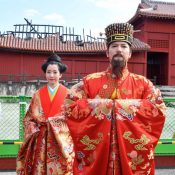
January 1, 2020 Ryukyu Shimpo
Shuri Castle Park’s annual New Year’s Banquet (Shinshun no Utage), a three-day festivity, held during the first three days of each New Year, opened again this year on park grounds on January 1, in Naha City, Okinawa.
It is the first New Year’s Banquet since the castle burned down in October.
Just as the previous years, many families and tourists visited the park to enjoy the ceremony, which was held before the castle ruins.
The guests wished for the castle to soon regain its former glory.
The ancient New Year’s ceremony of the Ryukyu Dynasty, the Imperial New Year’s Morning Ceremony (Chouhaiokishiki), is re-enacted every year at the Shuri Castle Main Hall, or the Seiden, and its courtyard, the Una.
As the three-day event was scaled down this year, the imperial morning ceremony was called off.
At the Lower Garden (Shichanu Una) of the Shuri Castle, the Ryukyu chamber music, Uzagaku, played as this year’s Ryukyu king and queen appeared. Guests took photos of the couple posing in front of the main citadel entrance (Houshinmon), with some of its framing still exposed.
Tsugunori Kedamori, 59, a school teacher from Yaese, and his wife Reiko, 58, said, “The Shuri Castle fire was heart breaking, but we’re hoping the castle will be rebuilt soon.”
Their daughter Yui, 17, a junior at Kaiho High School, commented, “I want to learn more about Okinawan history.”
Both domestic and international tourists visited Shuri Castle during the New Year’s festivities.
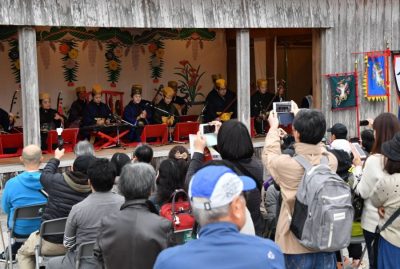
Visitors enjoying the Uzagaku performance at the Keizuza and Yomotsuza on Jan. 1, at the Shuri Castle Park in Shuri, Naha City.
Kiminori Sato, 44, a civil-service worker from Hokkaido, visited with his family.
He said, “We expected Shuri Castle to be closed, but we were excited to see more of the castle than we had hoped. We’d like to come back when it’s rebuilt.”
The New Year’s Banquet featured traditional Ryukyu dance and music, and Okinawan awamori liquor tastings to celebrate the New Year.
A bulletin board was set up in the basement level of the Suimui-kan, which houses the visitor center, and many left supportive messages, wishing for a swift reconstruction of the castle.
(English translation by T&CT and Monica Shingaki)
Go To Japansese
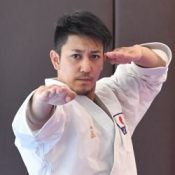
January 1, 2020 Ryukyu Shimpo
By Shun Furukawa
With currently no true rival in the world, Karateka Ryo Kiyuna is considered the Japanese athlete with the best chance of taking home a gold medal at the 2020 Tokyo Olympics.
While most only the world champion’s face makes its way into the limelight both domestically and abroad, the reality is there are many people who helped along the way.
In high school, Kiyuna never made it to a national championship. Somewhat of a late bloomer, the ability and talent came after lots of training.
“I will train 365 days a year.” This was before he became internationally recognized. It was the promise he made to Ryuei Ryu president Tsuguo Sakumoto when he knocked on his door at the end of junior high school.
That daily regimen of self-discipline and training had continued to this day, and has led to eight-straight All-Japan championships in the individual male kata, and three-straight world championships in the same category.
However, “the loss of strength, power coming and going, is something I am still working on,” he commented, showcasing his drive. Whether it is weight training, or thinking about where to look while on the floor and how to use his hands, he is an insatiable student of the art.
There is no quitting when it comes to delving even further into the profound kata.

Tsuguo Sakumoto (left), who leads the Ryuei Ryu Karate Association, training with Ryo Kiyuna (right). December 12, at the Sakumoto Karate Academy in Naha (Photograph by Moriaki Kise)
Sakumoto said of Kiyuna’s strengths, “He never lets up,” and noted that when he starts his kata in training, the dojo is instantly enveloped in a unique energy.
The 29-year-old’s embodiment of Ryuei Ryu’s characteristic “one step two fist” style and the essence of combining offense and defense has the look of a clear favorite as champion.
There are seven months until the Olympics. Until then, it seems that Kiyuna plans on a daily life that consists only of the strict internal battle to see just how far he can push the style and quality of the kata.
“I want to keep training with my sights set on the heights achieved by [Sakumoto] Sensei.” There is no hubris or carelessness.
There is only the training needed to reach the winner’s podium at the Olympics. While that is in the ]]corner of his eye, the focus is still on achieving the supreme kata.
Ryo Kiyuna: Born July 12, 1990 in Okinawa City. He began karate at age 5, and has won Japan’s national karate championship for 8-straight years since 2012, and won 3 consecutive world championships, in 2014, 2016, and 2018.
He has not lost an international competition since February 2018, and in 2019 he won the Asian Cup for the 4th-straight time.
He graduated from Konan High School and Okinawa International University. He is currently at the Ryuei Ryu Karate Association. 170 cm tall, 28 kg, age 29.
(English translation by T&CT and Sam Grieb)
Go To Japanese
December 27, 2019 Ryukyu Shimpo
The Ministry of Defense announced that new base construction at Henoko in Nago city would have an estimated total construction cost of around 930 billion yen, and would take approximately 12 years to complete. Due to soft ground conditions in Oura Bay spreading, construction costs have increased almost 2.7 times the 2014 estimate of 350 billion yen, and the return of MCAS Futenma to Okinawa has been pushed from sometime after 2022 to sometime in the 2030s.
As Okinawa had been indicating, Japan was forced to drastically revise their new base construction plan. While the project is one unprecedented in scale for Okinawa, it is easy to see that the government underestimated numbers to avoid backlash by Japanese citizens. This is one of the most complicated construction efforts ever seen in Japan, and there is a strong likelihood that costs and construction time continue to swell.
According to Okinawa, the initial investment for the relocation was around 147.1 billion yen. At this point in time, only 1% of the land reclamation work has been completed, while over one-third of the originally estimated 350 billion yen has already been used.
Furthermore, as they begin the massive effort of reinforcing the ground, it is hard to imagine that they will able to keep construction costs even under the new estimate of 930 billion yen. They must explain the construction methods they plan on using, as well as how the construction costs are being calculated based on this.
At the outset, when the government learned of the spreading soft foundation in Oura Bay, they kept that fact hidden from the Japanese public.
In a boring survey report compiled by the Okinawa Defense Bureau (ODB) in March of 2016, the results indicated that the firmness of the ground had an N-value of zero, like “mayonnaise.”
After the report was obtained via a right-to-know request filed in March of 2018, the government continued to be unclear about the existence of the soft ground. Later that year in the gubernatorial election in September, it should be considered that this put the candidate supported by the government at a disadvantage.
When a base-opposing candidate, Denny Tamaki, won the election, the government resumed construction in the bay, which had been previously halted. In December, the dumping of sand for land reclamation was forced through.
Even while knowing that costs and construction time were blowing up, they pushed through with land reclamation. It was as if they were trying to establish the fact that land reclamation could not be stopped. While they were certainly ignoring the will of Okinawans, they were also deceiving Japan as a whole regarding the use of taxes for base construction.
Japan’s national debt to GDP ratio is the worst amongst G8 countries. Spending such an astronomical amount of tax funds for a U.S. military base that will bring no return of investment is foolish.
Governor Tamaki has disclosed that an independent estimate calculates the total construction costs at up to 2.65 trillion yen, and will take over 13 years to complete, and that he has asked the government to discuss searching for a new way to remove the danger of MCAS Futenma. Starting with the soft foundation, Henoko is grappling with a number of issues that make it ill-suited for new base construction, already proving that it is not the “only solution,” as stated by the Japanese government.
If the government sticks to the current plan, it will corrupt Japan’s fiscal discipline and push the removal of the danger of MCAS Futenma even further into the distance.
The Japanese government needs to stop land reclamation immediately, and look to cooperating with Okinawa.
(English translation by T&CT and Sam Grieb)
Go to Japanese
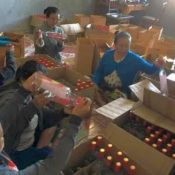
December 26, 2019 Ryukyu Shimpo
By Yuki Nakamura
In the new year, Co-Op Okinawa (Urasoe City, Okinawa) will begin importing the Lao traditional alcohol Lao-Lao into Okinawa to support industrialization in Laos. Currently, Lao-Lao is produced and sold in Laos and a portion of profits is contributed to solving regional problems such as poverty. Co-Op Okinawa plans to sell the alcohol in Okinawa, primarily in Co-Op Okinawa stores. The sales target for the first year is 7000 bottles with a planned price of approximately 1000 yen for a 500 ml bottle. The hope is to expand the operation beyond Co-Op stores.
Lao-Lao is a distilled rice alcohol and is said to be the predecessor of Awamori. In Laos, the liquor is made at home and privately sold by volume. However, in recent years, bottled alcohol has come into small towns from cities and sales of homemade Lao-Lao have declined.
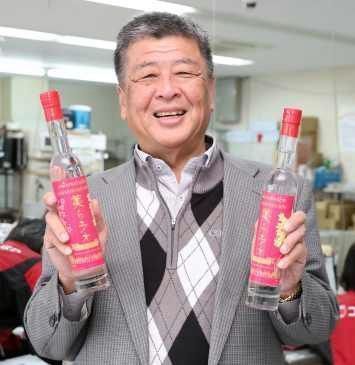
Osamu Ishihara of Co-Op Okinawa who helped commercialize Chura Lao. Nishihara, Urasoe City.
In 2017, Co-Op Okinawa established the Lao-Lao Alcohol Co-op, gathering 39 women distillers in the southern Lao town of Xay in order to commercialize Lao-Lao. In 2018, they set up a factory and a system for mass production. The organization is run exclusively by locals and as a result, operations and accounting are led mainly by four women who can read and write.
The women designed the package and bottled the alcohol for commercialization under the name Chura Lao. To guarantee the flavor, the Kumesen Sake Brewery in Naha is in charge of quality control. Chura Lao is sold in Laos for approximately 550 yen per bottle. The majority of the annual 8000 bottles sold are through restaurants and hotels. The plan is for 30% of sales to go toward paying Co-Op members, 20% to be retained within the organization, and 2% to be laid aside to tackle challenges such as poverty.
In Xay, where self-sufficiency is the norm, a household’s monthly income is between 3000-4000 yen. At the Chura Lao factory, workers can earn approximately 1000 yen per month only working once each week, so the factory contributes to raising wages.
According to Osamu Ishihara of Co-Op Okinawa, “In the past, they have just made the alcohol and sold it. By putting the alcohol in bottles and commercializing, value is created. This will help to lay the foundations of industry and solve poverty.”
(English translation by T&CT and Ellen Huntley)
Go to Japanese
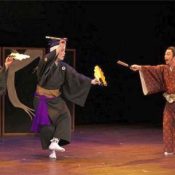
December 26, 2019 Ryukyu Shimpo
The play Gungwachi Kungwachi (Okinawan for May and September) by the Ryukyu Art Embassy was awarded Grand Prize in the Popular Entertainment category of the 2019 74th annual ACA National Arts Festival, organized by the Japanese government Agency for Cultural Affairs. Gunwachi Kungwachi entered in the Kanto Region division, and took the single Grand Prize out of the total 53 entries combined with the Kansai Region division. In the Kanto Region Music category, Tomokuni Terukina’s solo recital won the Excellence Award. It is the first time since Living National Treasure, Choichi Terukina won in 1979, for a traditional Ryukyu musician to win the Excellence Award in the Music category (formerly the Traditional Music category.)
Gungwachi Kungwachi is a comedy packed with a diverse array of performance art elements, including snippets of traditional Ryukyuan dance, the theatric kumiodori dance, and Sakishima islands-style dance. It was the first time the play was performed in Tokyo since its launch in Okinawa in 2013. Gungwachi Kungwachi was awarded Grand Prize for providing a “high level-composition that makes the traditional Ryukyu dance highly entertaining.” The judges praised the play for its cultural significance: “It provides an experience in the rich and unique Okinawan culture, which was borne out of its maritime trade.”
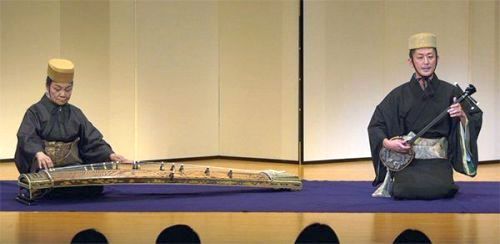
Tomokuni Terukina (right) performing Juu-shichi Hachi Bushi at the Kioi Hall in Tokyo on November 8. His solo recital won the Excellence Award in the Kanto Region Music category.
Tomokuni Terukina’s solo performance was awarded the Excellence Award for its “Wealth of inventiveness in the composition,” which combines the traditional Ryukyu folk solo song
Juu-shichi Hachi Bushi with
Kumiodori, Mo
Ashibi, and even traditional Ryukyuan dance. The judges said his performance “Fully conveyed the allure of Okinawan music and performance arts. [Terukina’s] beautiful voice has both softness and bounce, [and he] delivered the wide-ranging melody with vibrance. Coupled with the rich sound of the sanshin, the performance took on a multi-faceted expressiveness, which conveyed the varying emotions of each song and enraptured the audience.”
The awards ceremony will be held on February 13, 2020 in Tokyo.
(English translation by T&CT and Monica Shingaki)
Go to Japanese
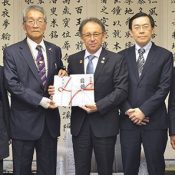
December 20, 2019 Ryukyu Shimpo
On December 19, Fan Chen-Kuo, the Taipei Economic and Cultural Representative to Japan in Naha, visited the Okinawan prefectural government office to present Governor Denny Tamaki with a donation to rebuild Shuri Castle, which had burned down in a recent fire.
While addressing the reporters, Fan took an optimistic stance on the use of the Taiwan Cypress in the Shuri Castle reconstruction: “We think reconstructing [Shuri Castle] is meaningful.
I believe Taiwan will consider any official requests made by the Japanese government or the prefecture of Okinawa.”
The Taiwan Cypress was used in the last Shuri Castle reconstruction work and is hoped to be sourced again, but currently, its logging is banned.
Fan commented, “At the time of the previous reconstruction, Taiwan’s [cypress] ban was already in place.
There are possible [workarounds].” He added, “In my personal view, some commercial enterprises may have stocks of the wood, and the Taiwanese government also has an inventory of collected full-grown cypress driftwood. They may be an option.”
Fan presented Governor Tamaki with a donation of 1 million Taiwanese dollars (about 3.5 million yen) on behalf of the Taiwanese government.
The Ryukyu Overseas Chinese Association (Ryukyu Kakyo Soukai, a group composed of Taiwanese citizens living in Okinawa) also donated 2 million yen, which was presented by its president, Mitsuteru Harimoto.
The governor expressed his gratitude: “I am touched by the warm support. We will work swiftly to rebuild and restore [Shuri Castle].”
(English translation by T&CT and Monica Shingaki)
Go To Japanese
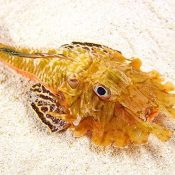
December 17, 2019 Ryukyu Shimpo
Motobu – The Okinawa Churaumi Aquarium has for the first time in the world put the exceedingly rare deep-sea oni armored searobin on display.
As the name suggests, armored searobins are characterized by scales that look like a suit of armor, however the oni has a bone on its head that extends into the shape of a saw, something almost unheard of in the animal kingdom.
The oni armored searobin lives in the shores and oceans of the Pacific.
According to the aquarium, remains have been collected by trawlers previously, however finding one that is still alive is incredibly uncommon.
In October, an unmanned submersible doing a survey at a depth of 350 meters, about 20 kilometers off the coast of Motobu, discovered one of these fish alive and was able to capture it.
It measures 25 centimeters in length, and moves using a basic pectoral fin to slowly walk across the ocean floor.
The fish is on display in the “Deep Sea Voyage” corner in the aquarium. Atsushi Kaneko, 43, who is in charge of the exhibit, said “I want people to know that this strange fish lives in the depths of Okinawa’s sea.”
(English translation by T&CT and Sam Grieb)
Go To Japanese
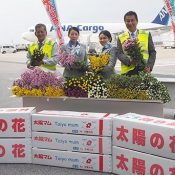
December 19, 2019 Ryukyu Shimpo
Okinawa’s chrysanthemum flower producers have welcomed peak shipping season ahead of the New Year.
To accommodate the increased output, the Okinawa Flower Grower’s Co-op set up an expanded delivery schedule in partnership with ANA Cargo.
Each cargo plane will deliver 4,000 boxes or 800,000 stems of mums to Narita Airport.
From there, the flowers will be transported to flower markets in the Kanto and Tohoku regions.
The floriculture co-op is scheduled to ship a total of 175,000 boxes of flowers in December, of which 165,000 boxes will be chrysanthemum flowers.
The shipments are expected to total 1.4 billion yen.
Although 2019 brought bad weather and a typhoon during the crop’s planting period, the storm missed the growing period, which resulted in an overall good season.
Shigeshi Miyagi, president of the Flower Grower’s Co-op explained that local growers are struggling as competitors in South East Asia have captured an increasing share of Japan’s domestic floriculture market.
Miyagi said, “Competition with foreign growers is unavoidable. We’re focused on locally produced, high quality [flowers] that will win the market.”
(English translation by T&CT and Monica Shingaki)
Go To Japanese
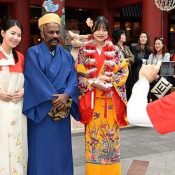
December 16, 2019 Ryukyu Shimpo
On December 15, an event called “Let’s Show Friendship Between Okinawa and South Korea” was held on Kokusai Street in Naha, Okinawa.
Visitors could take photos with female staff in traditional Okinawan dress, called ryusou, and Korean chima jeogori and eat Korean tteokbokki.
Many Okinawans and tourists participated.
The event was planned by travel agencies and hotels based in Okinawa.
Kimiharu Sakamoto, general manager at Novotel Okinawa Naha, does office work. According to Sakamoto, with the relationship between Japan and South Korea worsening, there has been a nearly 90% decline in Korean tourists compared to last year. He explains, “By sharing pictures of the event over social media, we can show that the relationship between civilians is still very good.
We hope this will draw tourists.”
Utako Torisu is a housewife who lives in Naha. Her daughter loves Korea.
Torisu says, “it’s unfortunate that it is getting harder to visit Korea.
I hope this kind of civilian event improves the relationship between the two countries.”
(English translation by T&CT and Ellen Huntley)
Go To Japanese













 Webcam(Kokusai Street)
Webcam(Kokusai Street)


